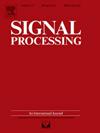立方 NK-SVD:在频率估计中设计参数字典的算法
IF 3.4
2区 工程技术
Q2 ENGINEERING, ELECTRICAL & ELECTRONIC
引用次数: 0
摘要
我们提出了一种新的参数字典学习算法用于线谱估计,适用于单测量向量(SMV)和多测量向量(MMV)场景。该算法被称为三次牛顿化K-SVD (NK-SVD),通过将三次正则化纳入牛顿细化,扩展了传统的K-SVD方法。所提出的Gauss-Seidel格式不仅提高了连续统上频率估计的精度,而且通过引入高阶导数信息实现了较好的收敛性。这项工作的一个关键贡献是在块坐标下降(BCD)框架内对所提出的算法进行了严格的收敛分析。据我们所知,这是第一次用高阶正则化方案对BCD进行收敛性分析。此外,我们开发的收敛框架具有可泛化性,为设计采用高阶正则化技术的交替最小化算法提供了基础。大量的模拟表明,三次NK-SVD在SMV和MMV环境下都优于最先进的方法,特别是在恢复近间隔频率的挑战性任务中表现出色。我们方法的代码可从https://github.com/xzliu-opt/Cubic-NK-SVD获得。本文章由计算机程序翻译,如有差异,请以英文原文为准。
Cubic NK-SVD: An algorithm for designing parametric dictionary in frequency estimation
We propose a novel parametric dictionary learning algorithm for line spectral estimation, applicable in both single measurement vector (SMV) and multiple measurement vectors (MMV) scenarios. This algorithm, termed cubic Newtonized K-SVD (NK-SVD), extends the traditional K-SVD method by incorporating cubic regularization into Newton refinements. The proposed Gauss–Seidel scheme not only enhances the accuracy of frequency estimation over the continuum but also achieves better convergence by incorporating higher-order derivative information. A key contribution of this work is the rigorous convergence analysis of the proposed algorithm within the Block Coordinate Descent (BCD) framework. To the best of our knowledge, this is the first convergence analysis of BCD with a higher-order regularization scheme. Moreover, the convergence framework we develop is generalizable, providing a foundation for designing alternating minimization algorithms with higher-order regularization techniques. Extensive simulations demonstrate that cubic NK-SVD outperforms state-of-the-art methods in both SMV and MMV settings, particularly excelling in the challenging task of recovering closely-spaced frequencies. The code for our method is available at https://github.com/xzliu-opt/Cubic-NK-SVD.
求助全文
通过发布文献求助,成功后即可免费获取论文全文。
去求助
来源期刊

Signal Processing
工程技术-工程:电子与电气
CiteScore
9.20
自引率
9.10%
发文量
309
审稿时长
41 days
期刊介绍:
Signal Processing incorporates all aspects of the theory and practice of signal processing. It features original research work, tutorial and review articles, and accounts of practical developments. It is intended for a rapid dissemination of knowledge and experience to engineers and scientists working in the research, development or practical application of signal processing.
Subject areas covered by the journal include: Signal Theory; Stochastic Processes; Detection and Estimation; Spectral Analysis; Filtering; Signal Processing Systems; Software Developments; Image Processing; Pattern Recognition; Optical Signal Processing; Digital Signal Processing; Multi-dimensional Signal Processing; Communication Signal Processing; Biomedical Signal Processing; Geophysical and Astrophysical Signal Processing; Earth Resources Signal Processing; Acoustic and Vibration Signal Processing; Data Processing; Remote Sensing; Signal Processing Technology; Radar Signal Processing; Sonar Signal Processing; Industrial Applications; New Applications.
 求助内容:
求助内容: 应助结果提醒方式:
应助结果提醒方式:


